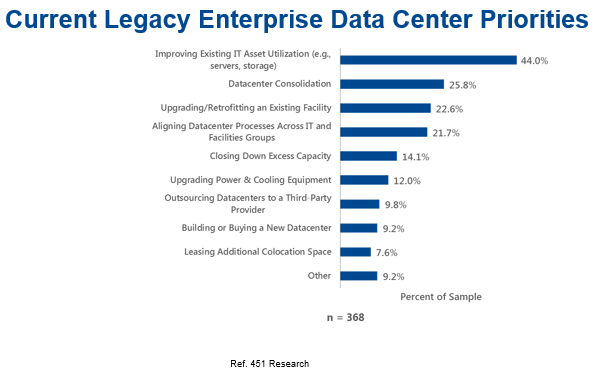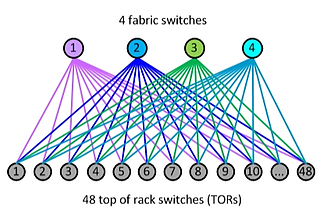Data Center Scalability: Why It Matters in Your Infrastructure
Data center operators struggle daily to accommodate scale – providing sufficient infrastructure to facilitate more demanding IT requirements (such as increasing compute, storage and network needs). This requirement for data center scalability is driven by the explosion in compute density from IoT, social media, on-demand video and global digital transformation.
Managing this growth requires systems and strategies that cost-effectively and efficiently support scale.
The Philosophy Behind Data Center Scalability
Your data center environment affects how you manage the scaling of infrastructure to support increasing data center requirements. No matter the type of data center - enterprise, colocation/multi-tenant data centers (MTDCs), hyperscale data centers or edge data centers - each needs the ability to grow quickly when needed.
Enterprise data center operators spend more capital dollars on improving existing IT assets over anything else (the consolidation of data center space, upgrading existing data center facilities and scaling IT, connectivity infrastructure and power/cooling infrastructure are next on the list).

Hyperconverged solutions – which combine separate storage and computing functions through software on a single device – can increase power density, but they also decrease available white space (available square feet). This requires data center scalability in enterprise settings.
Colocation/MTDCs must support increasingly demanding customer expectations. In addition to wanting power, space and cooling, for example, a tenant may also want an Infrastructure as a Service platform, pushing an MTDC to install cloud-based servers/systems. Working with wholesale customers forces MTDCs to masterplan power, space cooling and connectivity infrastructure well into the future.
Hyperscale data center operators offer scaling (up and down) as a standard customer offering; many have built-in scaling programs in all aspects of data center operations, including server deployment, software architecture systems, network design, facilities design/construction and facility operations.
Edge data center operators also need to plan for scaling as they manage data traffic at the end of the line, which can change rapidly on a day-to-day basis. Management teams need to plan for growth in not only network demand, but also in demands for power, space, cooling and real estate – and develop a consistent scaling methodology.
Data Center Scalability: Networks
CTOs and IT operations teams have access to several tools that can facilitate fast movement and support rapid network growth in an organized, systematic way.
Facebook’s growth in the hyperscale data center market is well known; it has been utilizing fabric scaling technology for several years to accommodate explosive growth in its social media platform and “machine-to-user” traffic. Facebook’s back-end services and applications are logically interconnected and rely on cooperation to optimize internal efficiency and reduce work.
Facebook’s next-generation data center is built around a disaggregated approach – small, high-performance server pods that connect to each other and to the data center.

Another method used today to quickly deploy data center infrastructure - hyperconvergence, which we mentioned above - collapses compute, storage, virtualization and networking into one platform, suitable for duplication across one or multiple data centers. Based on software and/or appliances, or supplied with commodity-based servers, hyperconvergence places compute, storage and networking into one package or "physical container" to create a virtualized data center.
Photo Courtesy of Facebook Open Source
Data Center Scalability: Facilities
In addition to network scalability, data center operators need to scale critical infrastructure (power and cooling) and space to accommodate explosive growth in compute power and storage.
MTDC operators need to develop strategic design plans to deliver power and cooling infrastructure quickly, efficiently and at the lowest cost possible without sacrificing the existing operating system’s reliability.
Critical power solutions can be deployed in a modular fashion, can be coordinated with IT system additions (the standby generators, medium-voltage line-up, power distribution systems and associated UPS systems can be pre-designed and fabricated as “just-in-time modules”) and can be installed within an operating data center while it remains fully operational and reliable.
Modular, factory-constructed critical cooling systems provide flexibility so that cooling can quickly be added to a new pod or data hall. Several cooling options are available (such as Vertiv’s Pumped Refrigerant DSE Room Air-Conditioning Unit or in-row cooling solutions) that provide a modular solution without sacrificing the need to retrofit chilled water systems. If the data center is large, and uses a chilled water/condenser water-based system, the chilled water plant (cooling towers, pumps, chillers and control systems) can be designed and deployed in a modular fashion to accommodate growth.
Finally, modular data center solutions offer building-block options that support IT infrastructure scaling and growth. These solutions can be deployed at a "building-size" scale or at the rack ("micro-data-center" level), which would house the server, switch and networking infrastructure and, in some instances, also contain critical power and cooling.
Bigger modular data center players (Baselayer and Data Centers Delivered, for example) can provide integrated critical power/cooling/DCIM systems that are factory installed, tested and commissioned before being delivered. Some micro-data-center firms (Schneider Electric and Instant Data Centers) may still need to be located within a building shell for security and environmental protection.
Data Center Scalability: Connectivity
Enterprise, colocation/MTDCs, hyperscale and edge data centers must all work to develop strategies to deploy standardized connectivity infrastructure (cabling, accessories and enclosures). Standardized systems and procurement processes help data center operators quickly ramp up installation of a new pod (for an MTDC) or provide framework and flexibility for moves, adds and changes.
Finally, implementing a standardized process for connectivity systems allows for pre-configured (one-SKU) solutions that help end-users streamline connectivity during purchasing, and provides a baseline set of standards for data center technicians working to accommodate scale and configuration of new and existing IT equipment.
Designing and operating a data center in today’s ever-changing environment requires strategies to accommodate data center scalability and flexibility. Belden offers data center preconfigured, single-SKU system solutions to make ordering a complete system easy, and decrease installation time. Learn more here.
